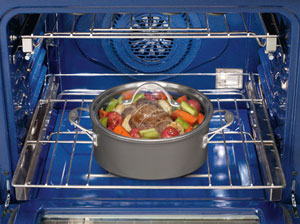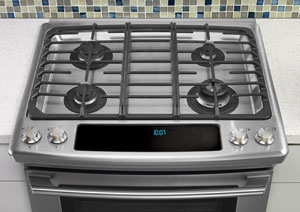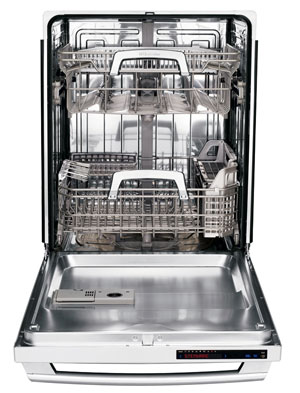Appliances for the Home: Sustainable Choices that Meet Accessibility and Lifestyle Needs
Wall ovens
The major decision when selecting an oven is choosing between gas and electric. According to New York Times Company-owned ConsumerSearch (www.consumersearch.com), which strives for objective and precise content, experts say electric ovens heat more evenly, have a larger capacity and are generally easier to install. Gas ovens, on the other hand, heat up and cool down faster. However, because ovens tend to be energy efficient in general, the difference is only about $25 per year. The biggest downside for gas is the potential for noxious fumes, especially in today's well-sealed homes. Gas appliances should, therefore, always be vented to the outside.
 |
Ramp-up high and low-mounted halogen bulbs enable viewing of food cooking in the oven. Easy glide racks will not tip when pulled out together. Photo: Electrolux Home Products, Inc. |
Electric models typically measure 27-in (3.5 cu ft capacity) or 30-in (4.2 cu ft capacity) wide and are available in a single oven or double oven configuration. New product features can include:
- Fade-to-black touch screen controls with a range of settings that include bake [2,450 watts (27-in)/2,200 watts (30-in]; broil [3,400 watts (27-in)/4,000 watts (30-in]; and convection [2,500 watts (27in and 30-in) for even cooking.] Other settings may include defrost; dehydrate (for drying herbs and fruit); bread rising; and multi-stage cooking.
- A variable-speed convection fan on duel-fuel and electric models provides faster and more even cooking.
- Easy-glide racks mounted on a ball-bearing system that move smoothly and will not tip if pulled out all at once.
- Enhanced visibility inside the oven achieved with an extra-large glass window plus high and low-mounted interior halogen bulbs directed at the top of dishes. Lights gently brighten and dim to achieve a "theater" effect.
- Adjustable baking racks allow multiple dishes to be cooked at once.
- Temperature probe for cooking the perfect turkey activated by pressing a single button.
- Door that stays put at whatever angle it is placed.
Freestanding and built-in ranges
 |
Free standing gas range with fade-to-black touch controls in front of the burners. |
Ranges can offer the same features as cooktops and wall ovens (see above), such as expandable electric elements and easy glide racks. Three configurations (dual-fuel, gas and electric) with fade-to-black touch screen controls can offer the largest capacity on the market by adding a lower electric oven. Capacity totals 6.7 cu ft (5.7 cu. ft. upper oven plus 1.0 cu. ft. lower oven.) The two ovens may be set at different temperatures if used simultaneously.
The same innovations found in wall ovens can also be found for ranges.
Warmer drawers. Freestanding and built-in ranges usually include warmer drawers. New warmer drawers can have digital press-controls and an average temperature range between 80 and 210 degrees. They work well with wall ovens, but can be installed separately.
Innovations can include:
- A versatilehalf-width rack.
- Four-hourautomatic power-off.
DISHWASHERS
Dishwasher technology has improved dramatically over the last decade. One improvement is increased capacity. For example, one standard size model can hold 180 items or a 16-place setting with serving plates. Another improvement is energy and water savings. ENERGY STAR qualified models use 40 percent less energy and 33 percent less water than conventional machines. A third example is improved sanitization. NSF-certified models have demonstrated they meet sanitization standards. Other innovations include:
-
Smart digital control panels. Some models offer a choice between fade-to-black touch screen and permanently visible digital control panel.
Photo: Electrolux Home Products, Inc.
- Enhanced dishwasher power drying using a high-efficiency fan that vents steam and water vapors out of the bottom instead of the usual top - so the dishwasher can be mounted beneath virtually any countertop surface, including granite.
- Improved quietness achieved in a standard size model by a tray-enclosed base that reduces sound and isolates electrical components and wiring.
- Soil sensors that test how dirty dishes are throughout the wash and adjust the cycle to achieve optimum cleaning with minimum water and energy use.
- Expanded water filtration that traps food particles as small as 150 microns so they do not settle on dishes. This permits the efficient use of detergent and water throughout the cycle.
- More efficient jets use less energy to spray detergent and water over the dishes when cleaning.
- Dedicated cycle for washing vertically stacked stemware.
- Adjustable and removable rack design that maximizes cleaning by strategically situating the dishes.
- Racks that glide easily.
- Leak detection system warns of leaks before they can cause damage. After detecting a leak it immediately stops and drains the appliance while sounding an audible and visible alarm.
- Door stays put at whatever angle it is placed.









